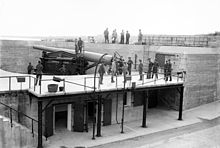10-inch gun M1895
| 10-inch Gun M1895 | |
|---|---|
De Bange type | |
| Carriage | M1893 barbette, M1894, M1896, or M1901 disappearing, most manufactured by Watertown Arsenal[3] |
| Elevation | disappearing: 12° |
| Traverse | disappearing: 170° (varied with emplacement) |
| Maximum firing range | disappearing: 14,700 yards (13,400 m)[4] |
| Feed system | hand |
The 10-inch Gun M1895 (254 mm) and its variants the M1888 and M1900 were large
History





In 1885,
After the
Experimental gun
A 10-inch "depressing gun" M1896 on an M1894 disappearing carriage was mounted in an experimental battery at Fort Monroe, Virginia in the northeast bastion. The battery was operated from 1900 to 1908, and the concrete portions remain in place.[7]
Railway mounting
After the
World War II
In April–May 1941 eight M1888 guns were sent to Canada under
Along with other coast artillery weapons, some of the 10-inch guns in the Philippines saw action in the
In 1940–44,
Surviving examples
Nine 10-inch guns (one partial) remain at four locations.[17]
1. Two 10-inch Guns M1895MI (#25 & #22 Watervliet) on Disappearing Carriages M1901 (#14 & #16 Watertown), Battery Grubbs, Fort Mills, Corregidor Island, Philippines. The guns lie behind their mountings, since they were fired while disconnected from the carriages to deny use of them to the Japanese forces.
2. One 10-inch Gun M1895MI (#20 Watervliet) (spare gun), Battery Grubbs, Fort Mills, Corregidor Island, Philippines
3. Two 10-inch Guns M1895MI (#26 & #28 Watervliet) on Disappearing Carriages M1901 (#13 & #15 Watertown), Battery Worth, Fort Casey, Coupeville, WA (guns moved in the 1960s from Battery Warwick, Fort Wint, Grande Island, Subic Bay, Philippines)
4. Two 10-inch Guns M1888 (#41 & #3 Watervliet), Fort
5. One 10-inch Gun M1888 (#12 Watervliet) on Barbette Carriage M1893 (#11 Watertown) (with partial remains of other gun (#37) and carriage (#1)), Fort McNutt, McNutts Island, Nova Scotia, Canada (guns moved in World War II from Battery Quarles, Fort Worden, WA)
See also
- Coastal artillery
- Seacoast defense in the United States
- United States Army Coast Artillery Corps
- Coast Artillery fire control system
Weapons of comparable role, performance and era
- 10"/40 caliber gun Mark 3- contemporary US Navy weapon
- BL 9.2-inch Mk IX – X naval gun - contemporary British naval and coast defense weapon
- Canon de 240 L Mle 1884 - contemporary French coast defense, siege, and railway weapon
References
- ^ Artillery Circular 1895, p. 184
- ^ Berhow, p. 61
- ^ Berhow, pp. 130–155
- ^ Berhow, p. 61
- ^ Coast Defense Study Group fort and battery list
- ^ Berhow, Mark A. and McGovern, Terrance C., American Defenses of Corregidor and Manila Bay 1898–1945, Osprey Publishing Ltd.; 1st edition, 2003; pages 7–8.
- ^ Northeast Bastion Battery at Fort Monroe, FortWiki.com
- ^ US Army Railway Artillery in World War I
- ^ Crowell, Benedict, America's Munitions 1917–1918, pp. 96–97
- ^ Miller, H. W., LTC, USA Railway Artillery, Vols. I and II, 1921, Vol. I, pp. 156-182
- ^ Handbook of Ordnance Data, 15 November 1918, pp. 97–108
- ISBN 1-86126-104-7.
- ^ Battery Harker article at Fort Wiki.com
- ^ Battery Quarles article at FortWiki.com
- ^ Battery Revere article at FortWiki.com
- ^ Berhow, p. 225
- ^ Berhow, p. 230
- Berhow, Mark A., ed. (2004). American Seacoast Defenses, A Reference Guide (Second ed.). CDSG Press. ISBN 0-9748167-0-1.
- Lewis, Emanuel Raymond (1979). Seacoast Fortifications of the United States. Annapolis: Leeward Publications. ISBN 978-0-929521-11-4.
- Miller, H. W. (1921). Railway Artillery. Vol. I. Washington: US Government Printing Office. pp. 156–182. (Vol. II at this link)
External links
- FortWiki gun type list
- Description of Seacoast Guns 8, 10, 12, 14, 16-inch
- TM 4-210 page at the CDSG
